I was in Lisbon alone for four or five days in 1994, I was in a surrealist movie, Manual of Evasion: LX94, directed by Edgar Pêra and featuring some great Portuguese actors plus me, Terence McKenna, and Robert Anton Wilson. I wrote up my 1994 impressions of the trip in a piece “The Manual of Evasion” that I’ve put online. (Originally it appeared in the old-school print version of Boing Boing, and in my book of essays, Seek.)
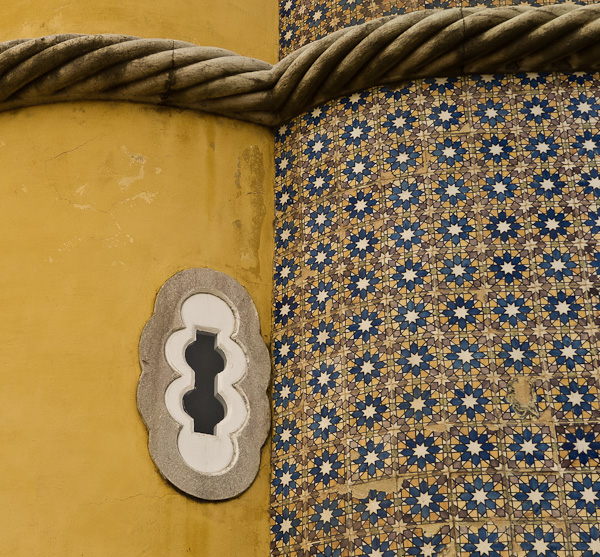
That first trip was a wild, happy time, and I’ve always had fond memories of it, and had wanted to bring Sylvia to Lisbon so she could experience this city too. Today I’ll blog about our trip, and post some of the photos I took, with a few of the photos by Sylvia. I have even more photos that I’ll work into future blog posts. You can also see my Lisbon photos (in a largeri resolution) in my Flickr set, “2011, Lisbon.”
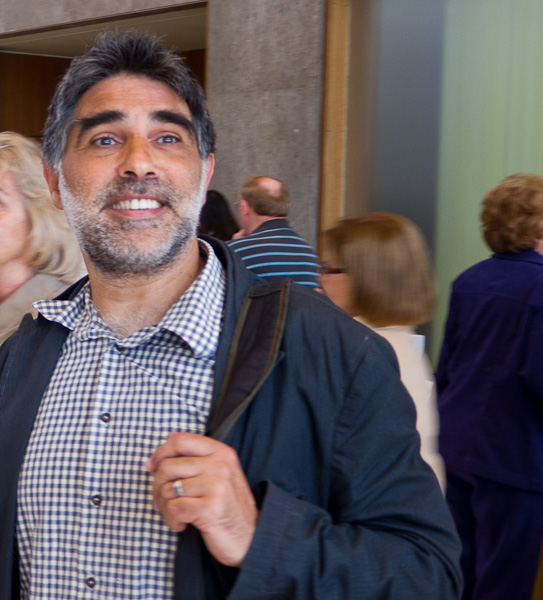
[Edgar Pêra]
Before setting out, I got in touch with Edgar, and he was still in Lisbon making films, getting plenty of work, and he was happy we were coming.
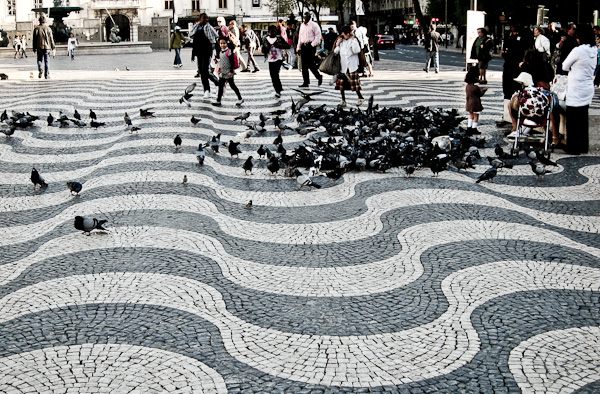
We got to Lisbon on April 2nd. We stayed at a nice mid-range hotel called the York House, it’s a small retrofitted convent in a residential neighborhood about two kilometers east of the main downtown. I picked it for sentimental reasons, remembering how much fun I had when I stayed there in 1994.
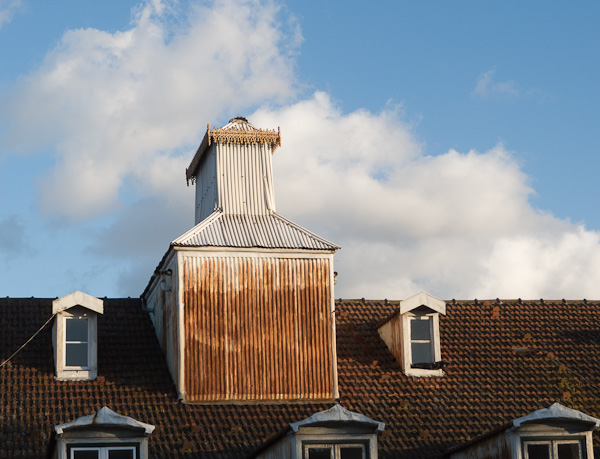
I loved the York House then, and I love it now. We ended up in cozy, quiet modern room with a view of a courtyard with a well and a hill of the city.
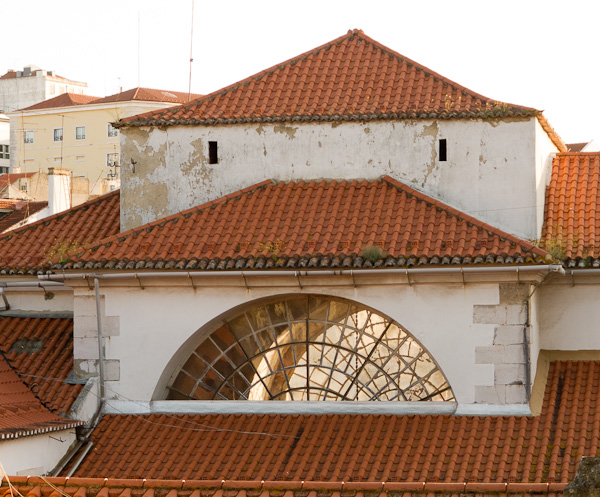
One of the closest buildings looked like a hippopotamus or maybe a monkey to me. Once I started seeing the face, I couldn’t “unsee” it, but that was fine. The monkey was my friend, and every morning the sun would light him up. We’d thought we might move to another town during out stay, but the room was pleasant, and moving seemed like too much trouble, so we stayed there eight nights in all.
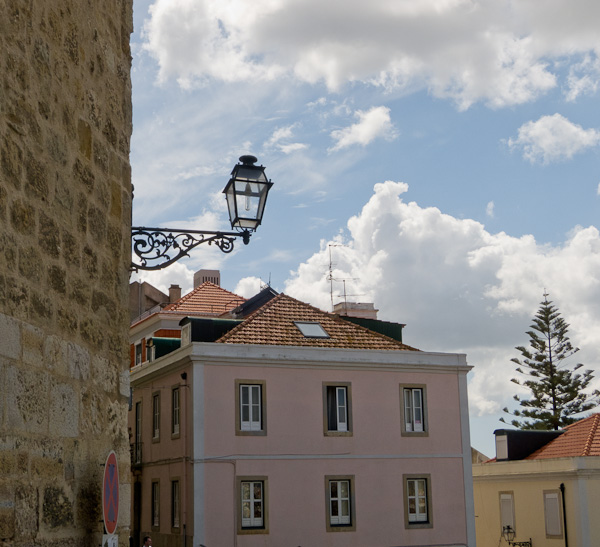
At first I had a little trouble readjusting to Lisbon. It’s always difficult—and sometimes disappointing—to revisit the places where you had good times in the past.
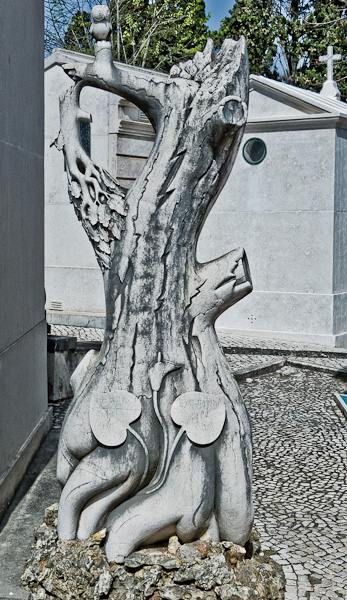
And coming back to Lisbon seventeen years after the last visit—well, Terence McKenna and Robert Anton Wilson are both dead, for one thing. Initially I felt wistfully haunted by their ghosts, and I missed them. Also, in Lisbon 1994, I was high on the local hashish much of the time Even though I’ve now been clean for many years, I did feel, more than usual, the strain of living life just as it is.
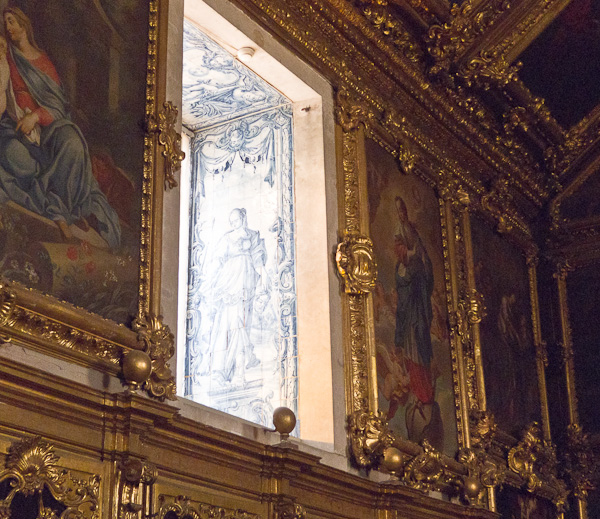
Basically I had to discover Lisbon again, this time with Sylvia along, and without having Edgar ferrying me around from one happening to the next. But after a couple of days we were fully into it.
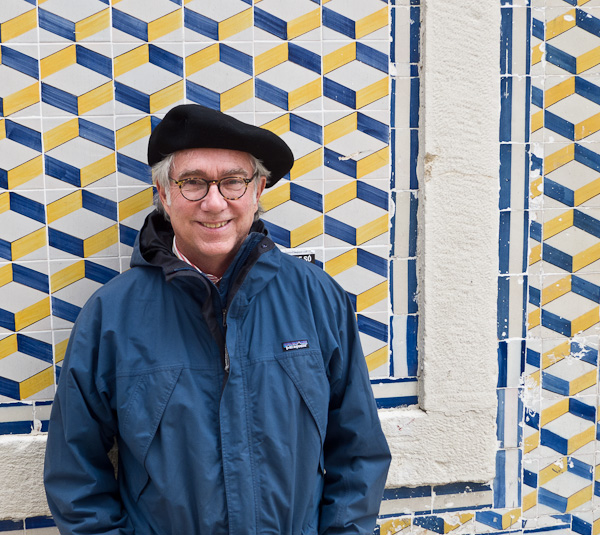
We had a wonderful time looking at Lisbon—touring Lisbon is more about just walking around than it is about seeing individual sights. Some days we’d walk up to a nearby cathedral, Basilica da Estela, which happened to be a place where you can catch a tram into town.

Working our way up the long hill, we marveled at how many of the buildings are covered with beautiful tiles, called azulejos in Portuguese. I love the tiles for many reasons. There’s a rich mathematical element to tilings, with interesting patterns to contemplate. They come in bright and exciting colors. And, washed by the rain as they are, they’re fairly shiny and clean.
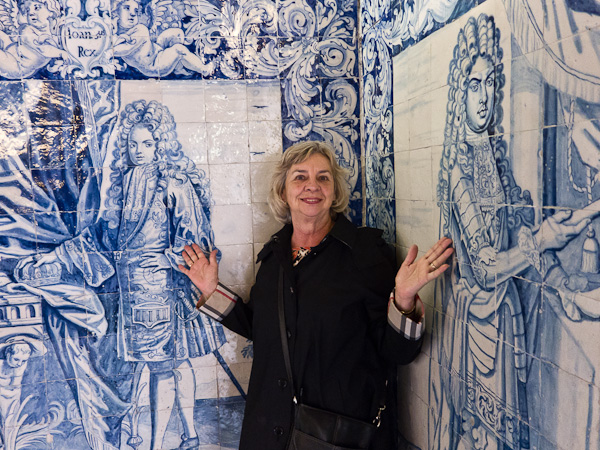
The most common tilings are repeating patterns, but some artists assemble large images from sets of unique tiles—murals constructed a bit like jigsaw puzzles, only the puzzle-pieces are squares 14 cm on a side. The 17th Century monastery São Vicente de Fora was filled with Delft-blue tile murals.
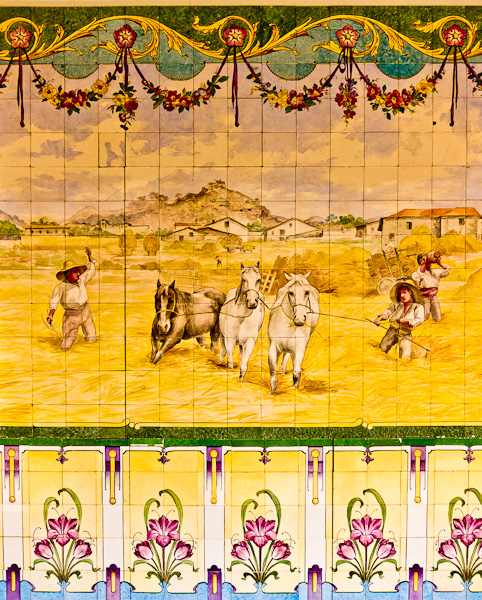
It occurred to me at some point that one of my favorite artists, David Hockney, has used the assembled-grid trick in two different ways—first in creating large images as collages of Polaroid photos, and, more recently, in making mural-sized paintings out of small modular canvases arranged in a columns and rows.
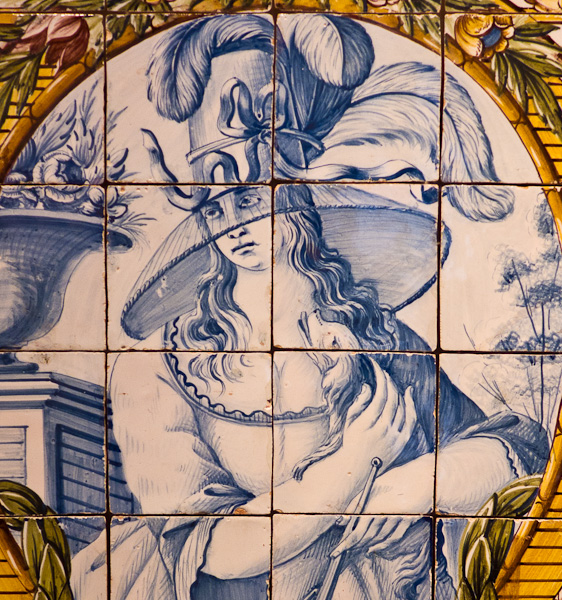
I got so into the tiles that I even visited the Museu Nacional do Azulejo, the Museum of Tiles, a smallish building, a bit out of the way, but with a nice cafeteria. They had some great nineteenth century tile murals.
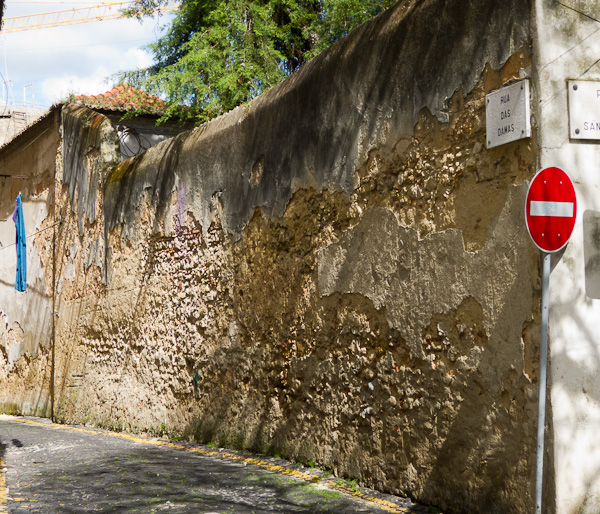
The first day, we hiked up the hill, eating some wonderful and unfamiliar pastries at a pasteleria, saw a wedding at the cathedral, and hopped on the 28 tram, which is by way of being (among tourists) the favorite tram in Lisbon, as it rattles up and down the hills of Lisbon like a slalom rollercoaster, and passes by some of the best-known sights.
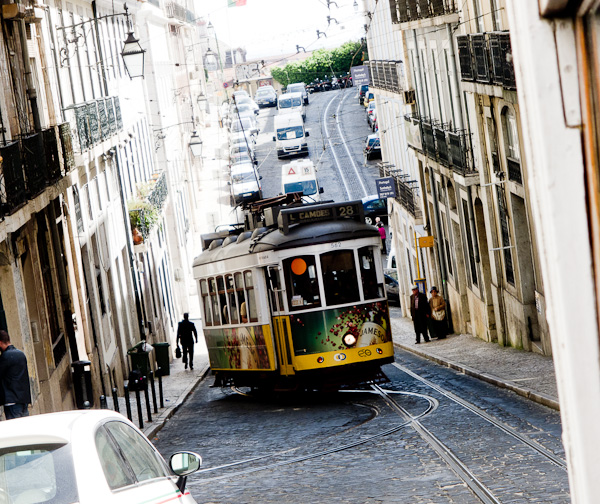
The Lisbon trams are single cars, as in San Francisco, but more streamlined, painted a bright yellow, and a bit shorter than most tram-cars, like minisubs. In spots the tracks are set down in zigzag to slow the pace up and down hills, and on the the tighter turns, the wacky trams swoop across the tracks going in the other direction so as to make the curve.
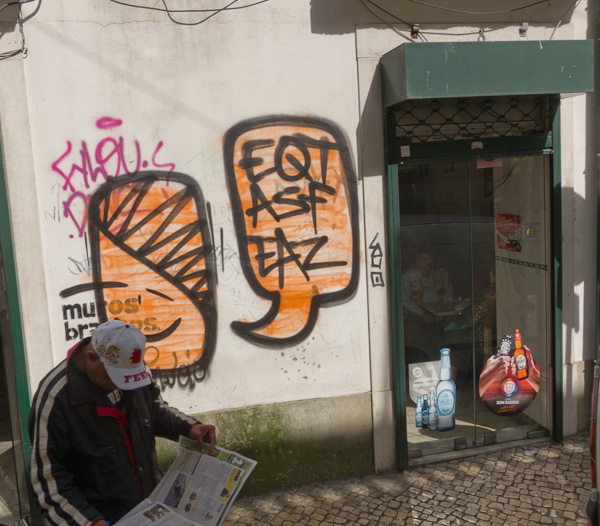
One of the pleasures of the trams is that the windows open all the way, so that you can ride along fully immersed in the environment.
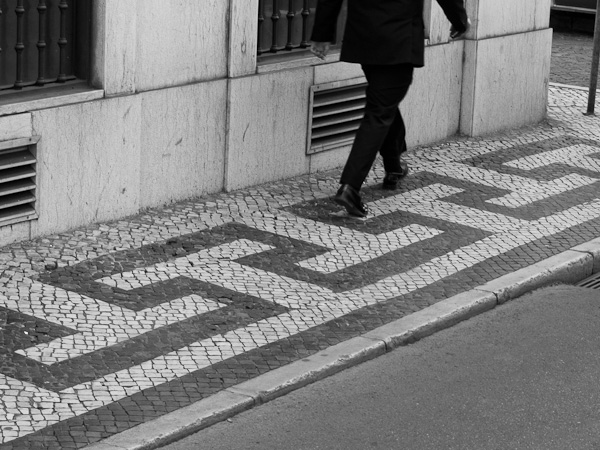
You’re part of the 3D spectacle of Lisboa street-life with hundreds of little scenes playing as you trundle by—not to mention the mini-dramas within the space of the tram itself.
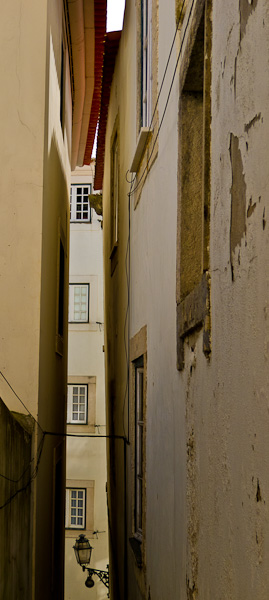
When Sylvia I we were downtown, we usually wandered the zillion quaint narrow streets, drifting down into the old Alfama neighborhood.
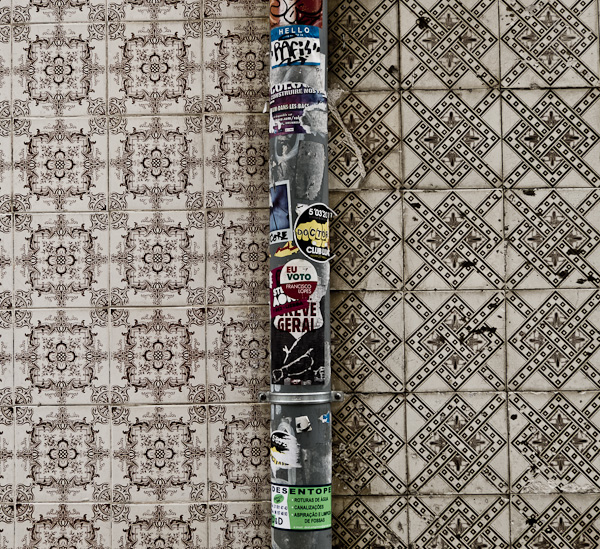
On the hills, with the numerous arches and alleyways, the tiled walls, the staircases, the flapping laundry, and the perspectives above and below, the scenes take on the quality of Escher etchings, with the dimensions looping back on themselves and bending around corners to shake hands.
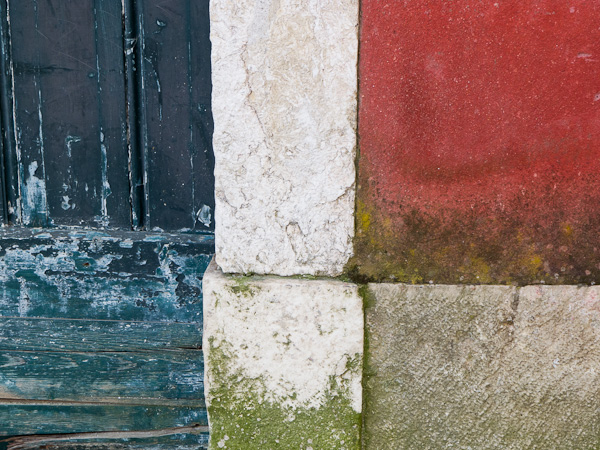
The patches of color fit together into wonderful abstract compositions.
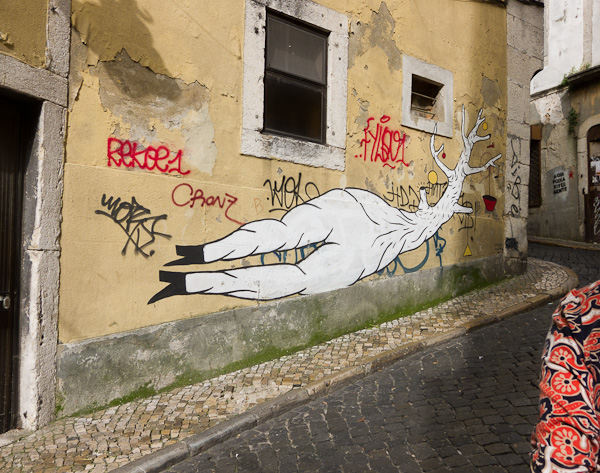
Another notable aspect of the street scenes is the very large amount of graffiti. In addition to the dull, standardized name tags, there’s a lot of really large and Mediterranean-feeling splashes of color. There’s also some nice stencil work as well.
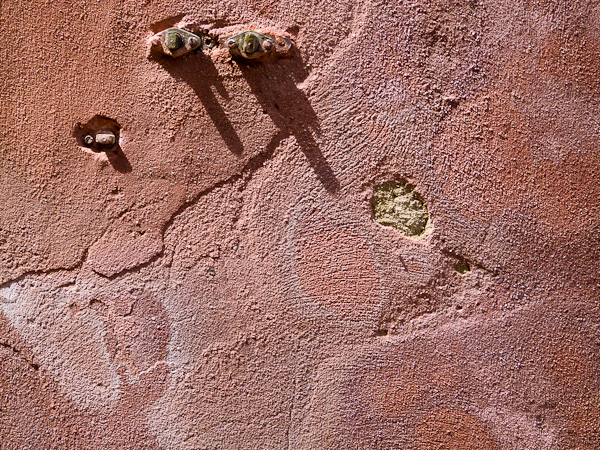
For that matter, even the plaster is interesting.
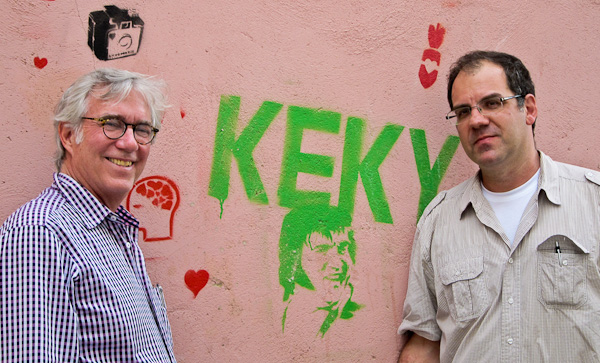
At one point we managed to connect with a Portuguese writer, Rui Zink, who took us along the street where he was born, in a neighborhood near the Rossio square, a bit livelier than the Alfama.
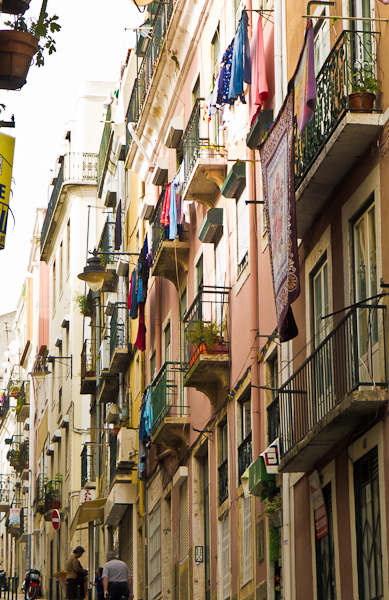
He was proud that the most famous of the Portuguese fado singers, Amalia Rodrigues, had been born in his neighborhood. Like many Portuguese authors, Rui has few books out in English—his but see his children’s book, The Boy Who Did Not Like Television.
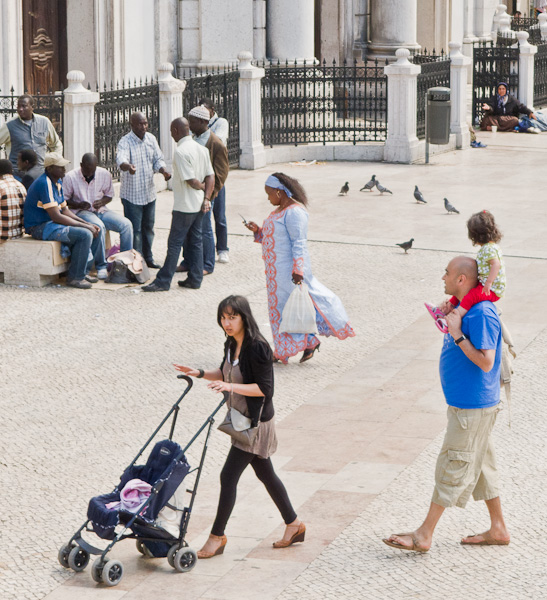
Sometimes Sylvia and I would sit in a cafe people-watching, with great characters walking by: intense Portuguese, Euro-hipsters, Africans, old people and people with babies, everyone quite mellow and tolerant with each other.
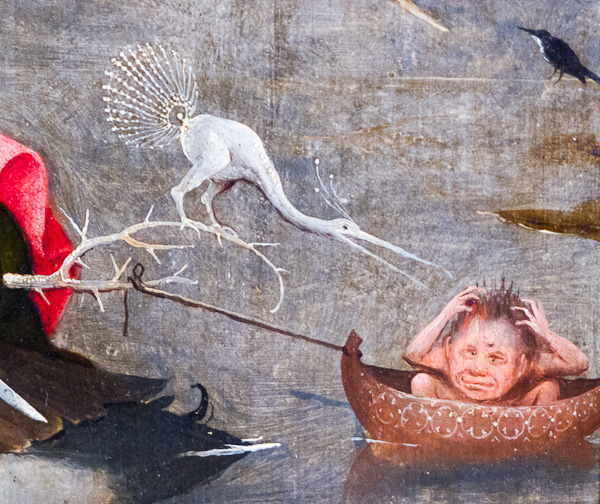
We also got together with my old director, Edgar Pêra. One day he met us at the hotel and escorted us to the art museum down the block, the Museu Nacional de Arte Antigua—it’s the biggest art museum in Portugal.
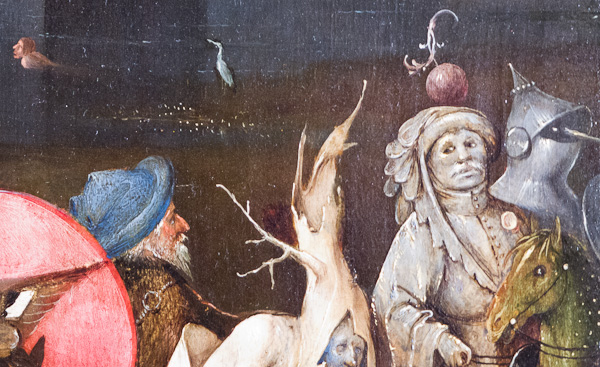
As this was Monday, the museum was closed, but Edgar’s production company had gotten permission to film there. He took me to Hieronymus Bosch’s Temptation of St. Anthony triptych—where a film-crew of six awaited, with lights set up, ready to film me with the Bosch masterpiece in high-def video. Now that’s the kind of welcome I like at a museum!
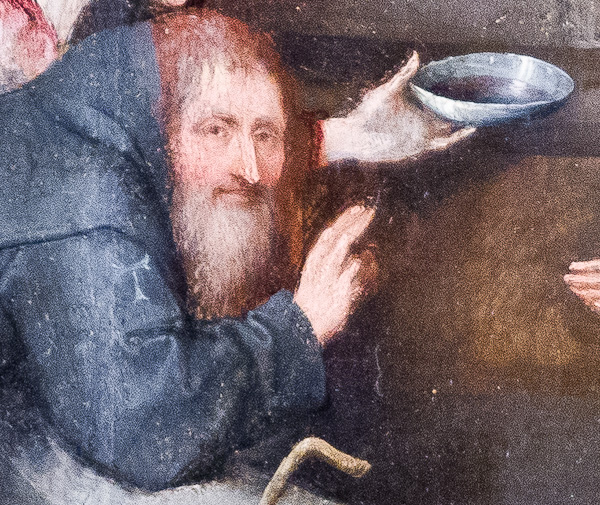
Edgar asked me a few leading questions, and I ended up talking about the painting for about forty-five minutes. The reason we’d set up this shoot is that, a couple of years ago, I thought a lot about this particular Bosch triptych. It appears in my novel Hylozoic, where my main character Jayjay is working as an assistant to Hieronymus Bosch himself, and Bosch is in fact working on the the St. Anthony triptych. I see St. Anthony as Bosch’s transreal representation of himself. You can find some of my research notes on Bosch in my Writing Notes for Hylozoic, which is downloadable as a free PDF at my Hylozoic web page.
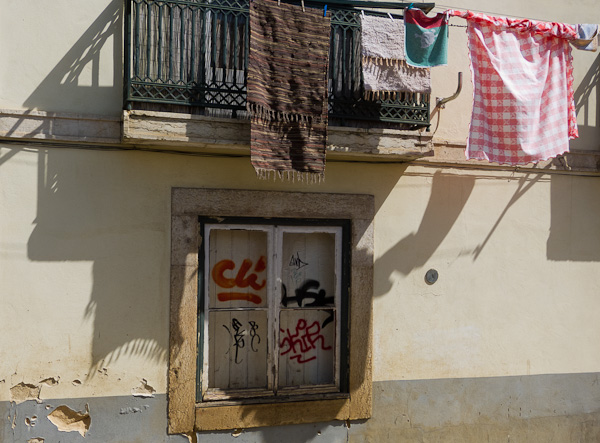
In conversation, both Edgar and Rui Zink were fairly critical of Spain. It’s taken considerable determination and individualization for Portugal to stay independent of Spain all these years. Speaking of the Spanish language, a Portuguese might say, for instance, “They use flat, simple, vowels, all the same. That’s why they can’t learn Portuguese.” Note that the Portuguese language has a lot of vowel sounds with a slide in the middle or at the end, also it has many sibilant sounds. It’s often remarked that spoken Portuguese sounds a little like Russian.

Sylvia and I had a number of memorable meals—maybe the best was a lunch in a hole in the wall in the Graça neighborhood above Alfama. It was all locals there, very casual, with fresh-caught fish. Near the end of our meal, a guy came by to spray the street.
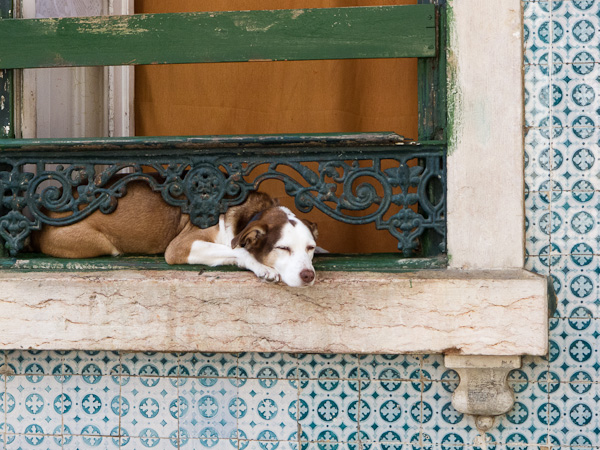
A dog lay sleeping in a window, now and then glancing over at us.
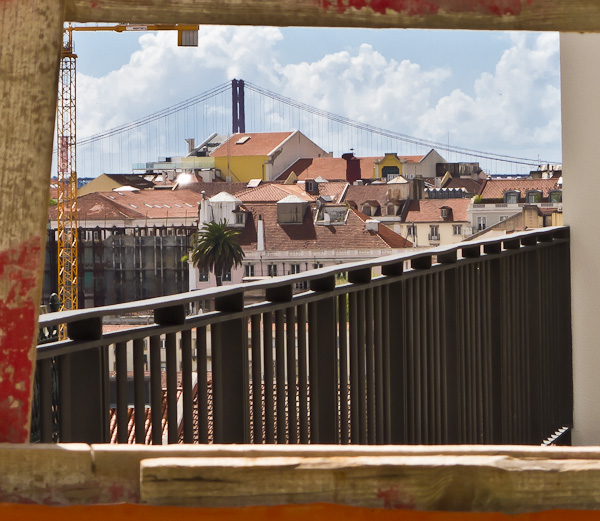
[The bridge across the Teja resembles the San Francisco Golden Gate.]
We had another awesome lunch in a tiny village called Porto Brandão which we reached by riding a cheap ferry from Belem across the Teja river that marks Lisbon’s northern edge.
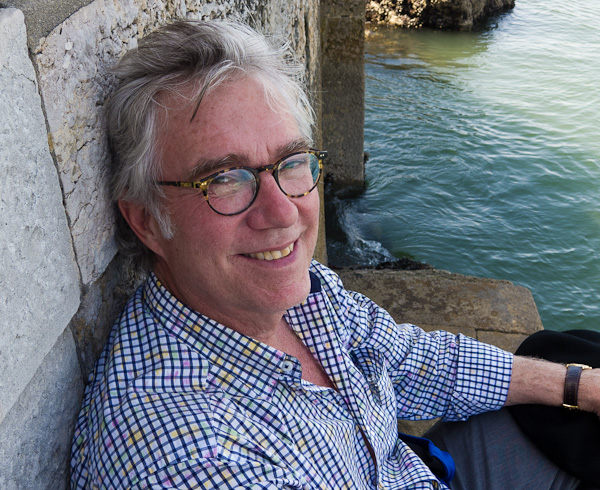
At this place—it’s Mare Viva, the big but not imposing restaurant facing the water—we had a lobster stew, unwisely ordering a portion for two, which included the meat four spiny lobsters. The portions in Portugal tend towards the huge.
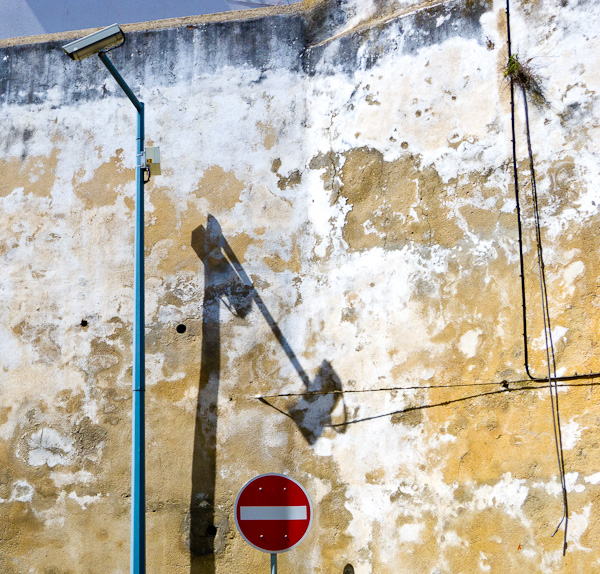
[Dig the space-warped look of that street-lamp shadow. And the wall itself!]
As in Spain, going out to dinner in Portugal takes patience, as you can’t really go into a restaurant before 9 pm. If you break down and go at 8, you’ll either be completely alone or at the mercy of chatty American tourists. We had a lot of cod, some octopus, sole, olives with everything, and, worth mentioning again, the amazing pastries.
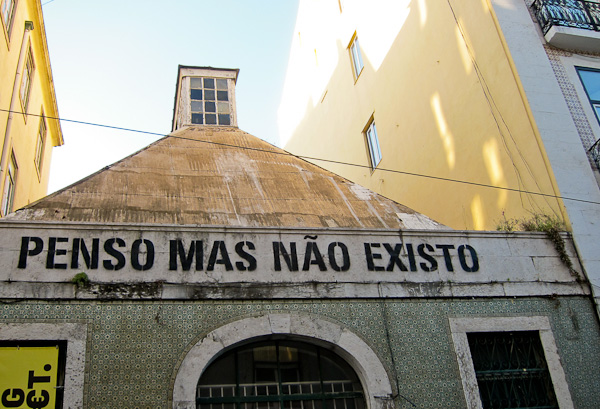
[The sign means “I Think But I Don’t Exist”. I think.]
The fanciest dinner we had was with Edgar Pêra and his friend Joana Amaral Dias. They drove us to a place on a hill overlook Lisbon and the Castelo de São Jorge. A big celebrity was eating at the next table, the now-retired Portuguese soccer great, Eusebio, who played for the Benfica team.
Joana is a very interesting person, beautiful and witty, a sometime member of the Portuguese parliament, and the author of a best-selling 2010 Portuguese book, Maníacos de Qualidade, (Maniacs of Quality) describing eight odd-ball characters in Portuguese history.

Sylvia were impressed to actually see Joana on TV the next day, debating the merits of the proposed 80 billion Euro bailout of the Portuguese economy by the EU. We had no way of understanding a word, but she had good presentation, speaking intensely, then ending with a smile. I hope some English-language publisher picks up her book.

One day Sylvia and I took the train to Sintra, a village about forty minutes from the city center.
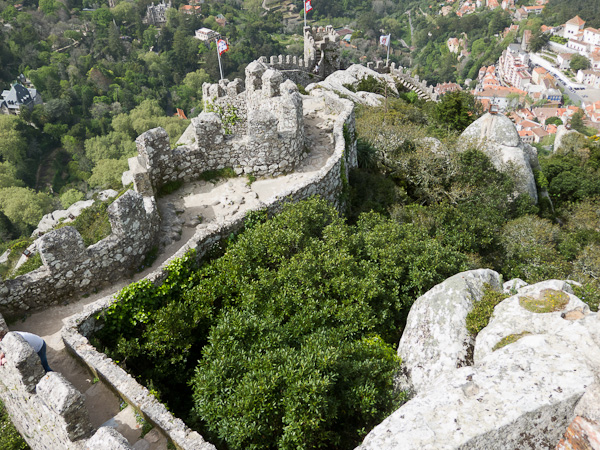
We climbed the insanely long rampart wall of a 9th century Moorish castle. It was a rough trek for us oldsters, with uneven footing, but we made it to the top.
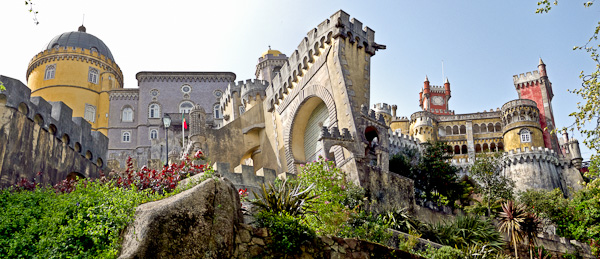
[Click to see larger image.]
And then we walked around a folly of a Romanticist castle nearby, the Palacio da Pena built on the ruins of a monastery around 1850.
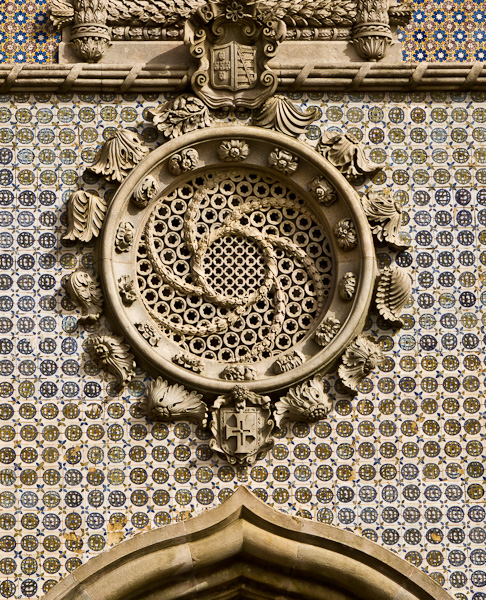
Love the snaky stone vortex amid the orderly tesselation.
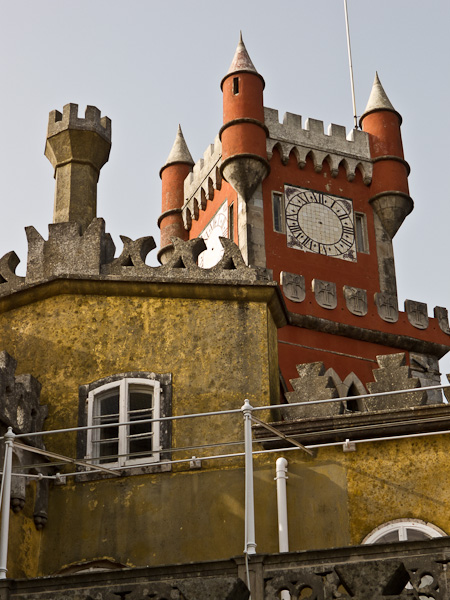
The place was quite hallucinatory.
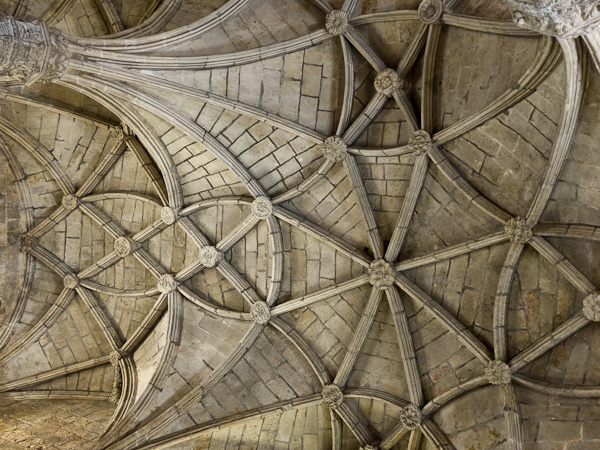
Another big site we saw was the Monasterio de Jerónimos in Bélem, a few kilometers east of town. This place was built in the early 1500s when Manuel I was riding high off the money the Portuguese were bringing in from Vasco da Gama’s newly-discovered route to India. The ceiling in the chapel is just outrageous.

As were the arcades.
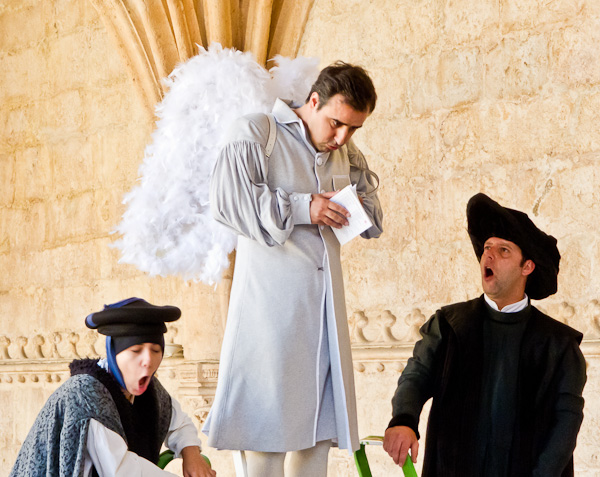
Some locals were putting on a funny medieval play about people trying to get into heaven, Gil Vincente’s “Auto Da Barca Do Inferno.”
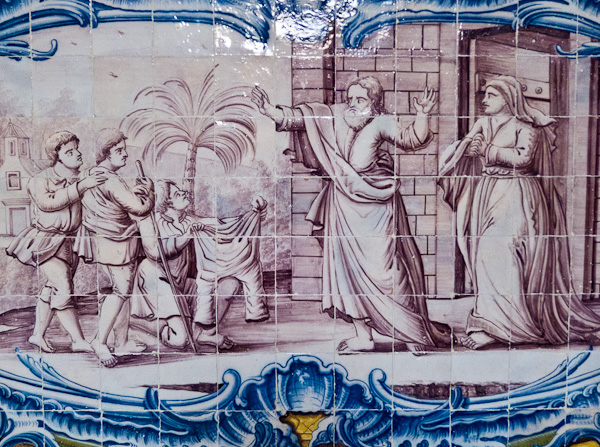
And a tile mural apparently depicts a Bible scene when locals ask Joseph of Egypt why the hell he can’t start wearing pants?
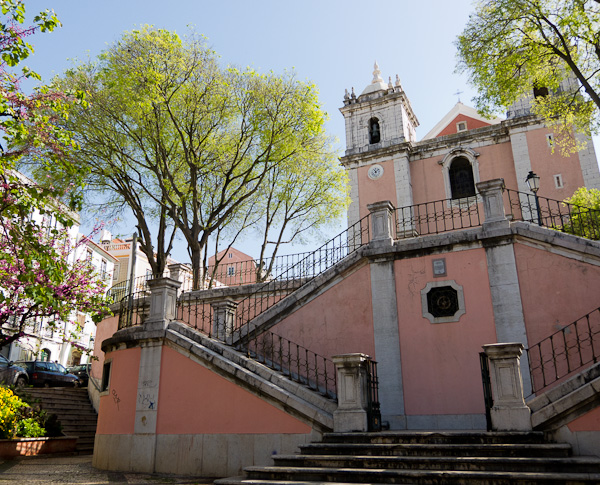
We visited a lot of churches, at least a dozen, maybe twenty, starting with the pink one down the street from the York House. If nothing else, a church is always a shady spot where you can comfortably sit down.
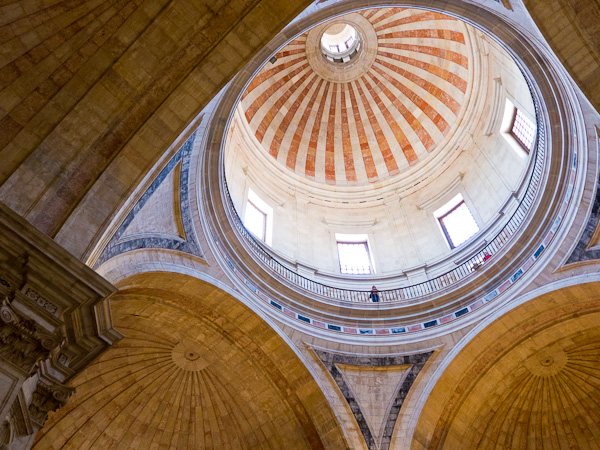
[This dome is in the National Pantheon, not really a church.]
And then you can stare up at the great, high vault, and study the quirky religious art. It’s odd how much energy people have put into obsessively depicting the same little constellation of possibly mythical events.
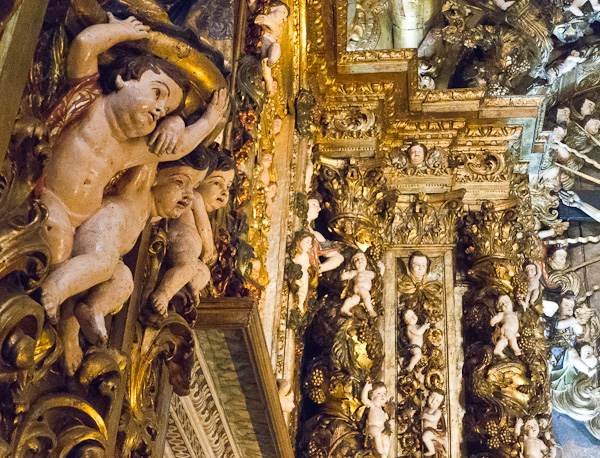
One of the more striking churches was the Igreja de São Roque in Bairro Alto, one of the higher areas that surround the low Baixa downtown. It had side chapels with sculptures and haut-reliefs encrusting their walls and ceilings. Two or three of the chapels were infested with angel babies, teeming, pullulating, like meal worms in flour, like maggots in decaying flesh, like thousand-headed litters of rats. Really kind of disturbing.
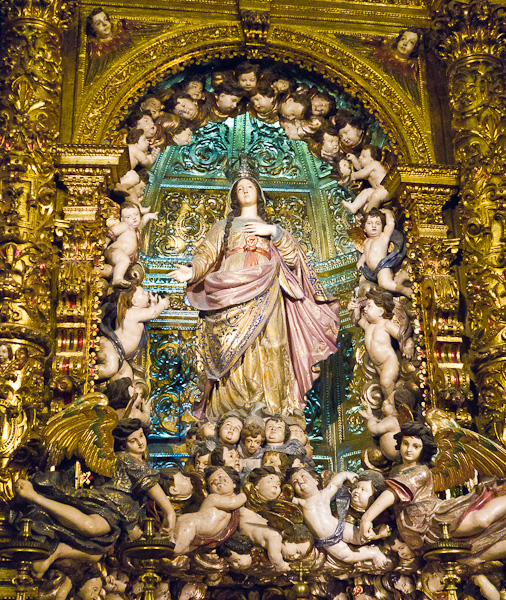
And in the center of one of these chapels was a statue of—the Virgin, with a heap of angel-babies accumulating in mounds beneath the hem of her robe. Why don’t the call Mary the Mother instead of the Virgin? That would make a lot more sense. Why try and separate the basic reality of sex from reproduction? Christianity is hella strange. But, of course, all religions are. The really weird doctrines serve as hooks that make the faiths stick in your mind.
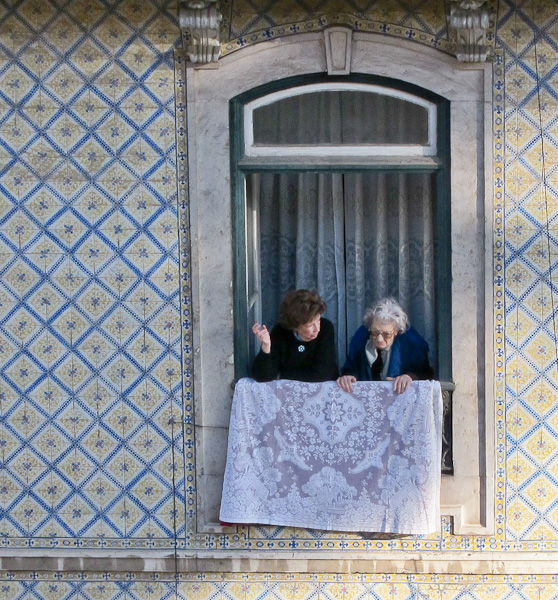
At one point we saw a funeral go by with a brass band, the horns long-winded and melancholy, in a gorgeous way. They played that funeral march that you hear in old-school cartoons: DAH-DAH-dah-DAAH-DINH-dah-dah-dah-dah-dah-DAAAAH. Across the street, two old ladies in a window prayed over the cortege.
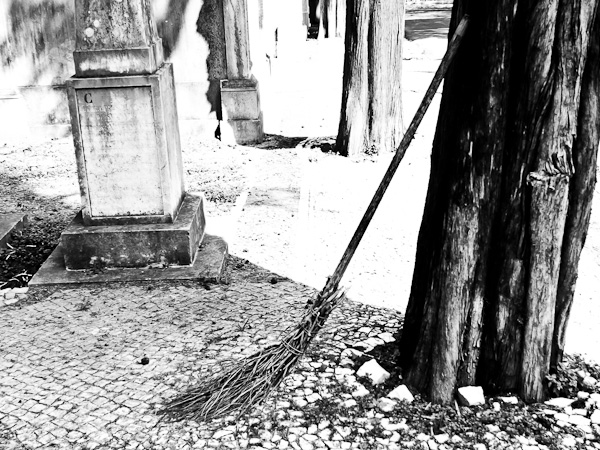
[Genuine “witch broom” spotted in the Cemetery of Pleasures.]
Another day we visited an old graveyard, the Cemitério dos Prazeres, or Cemetery of Pleasure, which struck us as depressing. When we were younger, graveyards seemed funky and fun, but we’re realizing that we’ve reached the point where we’d rather not spend any time in them at all. We’ll be there for good soon enough. This said, the place was very scenic, with rows of marble mausoleums amid cypresses, graveyard cats slicking around, and icons of winged hourglasses. “Time flies! What the f*ck am I doing in a graveyard? Outta here.”
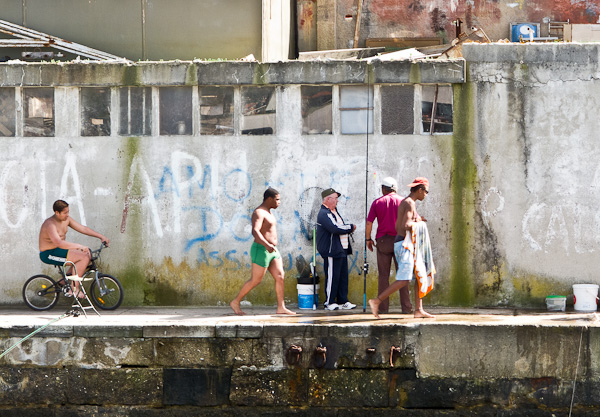
Seeing so many babies and old people, not to mention that wedding and a couple of funerals, and all the tombs in the churches, I started thinking about the wheel of life, and how things change. Walking along I’d sometimes ask myself: Am I deliriously happy? Why not? I’m on a great vacation! But of course my legs were increasingly tired. And I had that slight, nagging desire to get high.
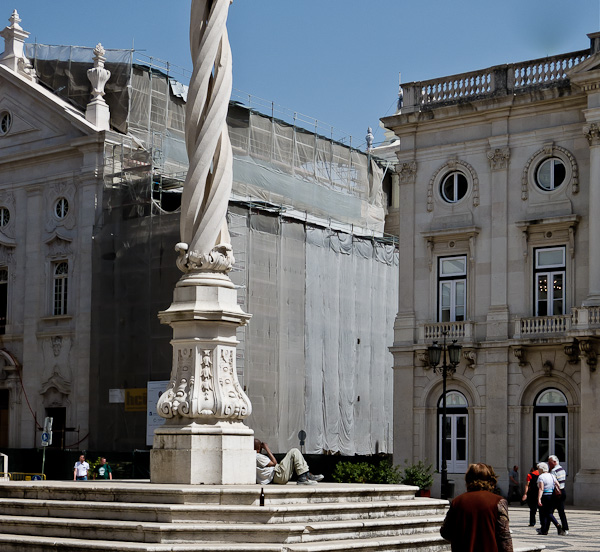
[Statue like a strand of DNA, with a drinker lounging at its base.]
Thinking this through having a mug of tea at a place called “pois, café” (pois means “yes”) near the Sé (cathedral) one afternoon, I remember that I can in fact be high in the now-moment. Preachy word-mongering or profound truth?
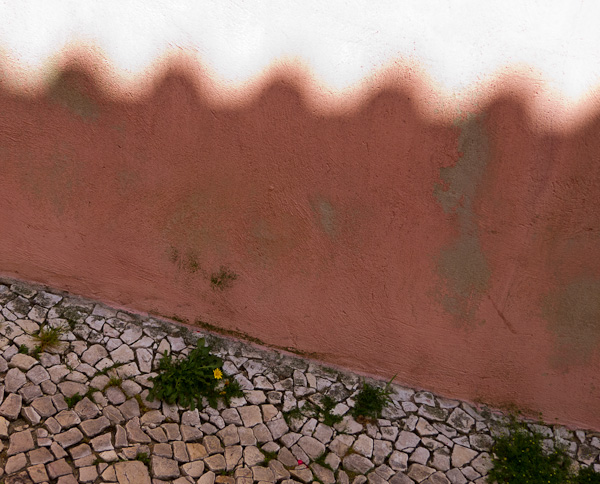
[Shadow of a tile roof on a pink wall, with the ubiquitous cobblestone sidewalk.]
I look at the chairs and tables, just so. The light on their surfaces. The azulejo tile logo on the truck outside, loving the sensory impact of the colors. Tiles on the facing wall across the narrow street. I’m high.
After all, what did getting high really do for me in the old days? It detached me from my worried, got me to see the world as shapes and colors, and put me into the now. But, aha, I can do all of that without taking anything!
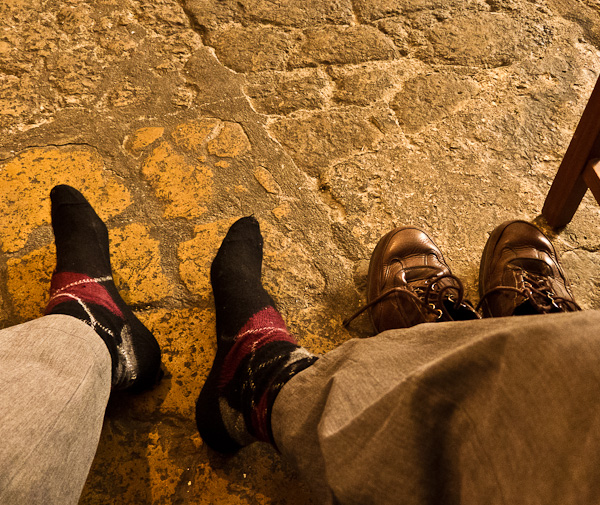
I’m relieved at being seated, with every part of my body awake, sweaty, throbbing from my wanderings around town. I take off my shoes and savor the coolness of the rough, ancient stones haphazardly assembled to floor this high-ceilinged room—might have been a workshop or a stable once.
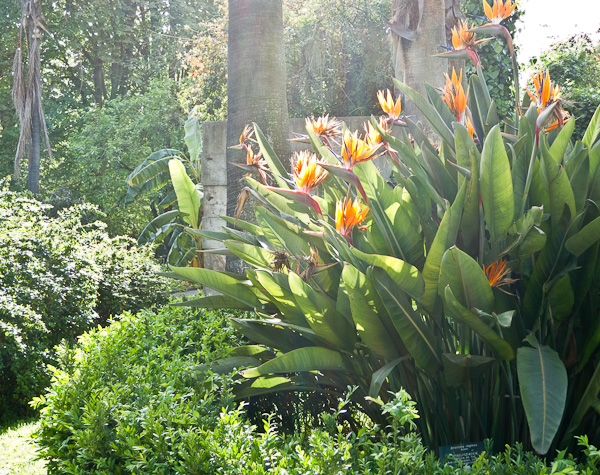
Writing helps me center, helps me be high. And isn’t it great to be without a cellphone, off the grid, beyond telephonic intervention, where whatever I’m up to is, like, “It is what it is.”
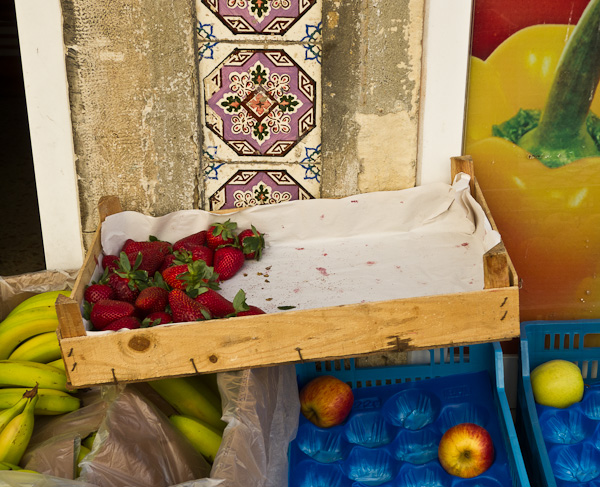
I learned that catch-phrase in 1988 from our then-new friend Faustin from Mill Valley. At first hearing, it struck me as mystically profound, like the first hearing of “All if One,” or “Be Here Now,” or “Let it come down.” It’s all about turning off the gerbil-wheel of carking, swinking care. “Put it all down, only go straight.”
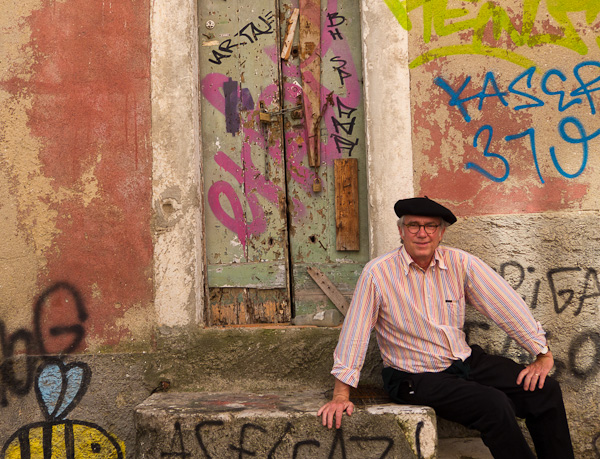
The next day I was resting on a park bench with Sylvia, wearing my floppy blue wool beret against the intense southern sun, and I took of my shoes again. A woman gave me a look. Oh, oh! I was a Beat Barefoot Bum in a Beret!









April 20th, 2011 at 11:52 am
Truly magnificent photos of a beautiful place! Thanks for sharing your travels with us.
April 20th, 2011 at 2:26 pm
I am a Portuguese follower of your blog (and a sci-fi lover) and it was really surprising to see photos of our capital when I read this post, let alone the pictures of Rui Zink and Joana Amaral Dias. If you ever come back to Portugal, maybe you would like to visit its second biggest city, Oporto. It is a wonderful city, with a great History and sights (and great Oporto wine, too :)). Also, there are many sci-fi lovers who would be very pleased to show you around. Drop us a line!
April 20th, 2011 at 10:54 pm
Great photos, great memoir of your trip. It’s like a little trip to Lisboa: Portuguese sky, azulejos, trams, graffiti, and all those wonderful brick and stucco buildings. Glad you caught up with Rui and heard what he thinks of Spain.
April 21st, 2011 at 8:42 am
Dear Rudy. Having a really sh*tty day, but I really enjoyed looking at your pictures and thinking about Lisbon. Thanks! Thomas
April 21st, 2011 at 9:36 am
Is this movie available anywhere in full? I would love to see the whole thing!
April 21st, 2011 at 10:24 am
Thanks, SMP, I would have liked very much to visit Oporto, as well. Next time!
Justin, re. the full-length MANUAL OF EVASION: LX 94 film, Edgar would like to get it released on DVD, but hasn’t managed that yet. I think there are some older VHS versions floating around.
April 23rd, 2011 at 2:53 am
I lived in Lisbon for a few months last year and fell in love with the place.
I met so many warm and interesting people there, really enjoyed struggling with the language (it’s really tough) and also learning the long and often difficult history of its people. I feel it’s a shame that it’s almost treated as a third world European outpost sometimes, economically and culturally. So despite my love for the country, the Povo, and it’s amazing treasures I decided to move to Berlin.
If you do get the chance to go back make sure you get to see the Cromleque dos Almendres that overlooks the city of Évora on the Summer Solstice. Then you can go and cool off in the Capela dos Ossos.
April 25th, 2011 at 7:04 am
Rudy, as I am in the middle of a class on Chaucer I was pleased to notice that ‘swink’ is still in circulation. The beret look fits you and it’s always good to get a dirty look from the middle class!
April 26th, 2011 at 4:53 pm
Lovely post. Felt like I was along for da ride.
April 28th, 2011 at 5:39 am
Hi Rudy,
thanks for sending me to your blog for the photos of Portuguese tiles — great shots, and a little view of your recent visit. Enjoyed pizza and a chat with your family in Berkeley last night — hope J has recovered from the bee sting — your little puppet certainly distracted her. jj